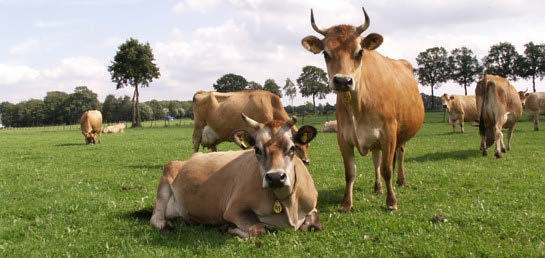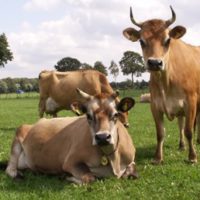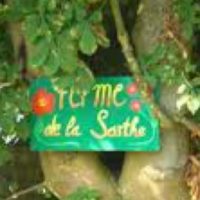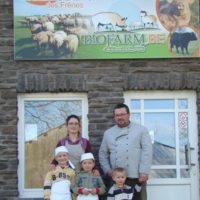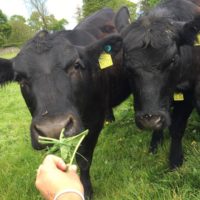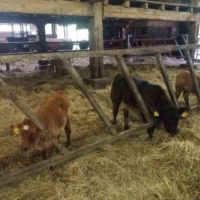Kurzrasen in Lunteren
Description
Background
Jan Dirk van der Voort is a dairy farmer in Lunteren with 85 Jersey cows. Lunteren is located in the middle of the Netherlands. The type of soil in this part of the Netherlands is sand. The philosophy of Van der Voort is to work close to nature and only use natural resources. The entrepreneur processes on-farm the milk of the dairy cows into cheeses. The cheese is entirely made, matured and traded in-house. It is sold under the brand Remeker (www.remeker.nl). All the milk that the cows produce is for the preparation of cheese and not even one liter of milk has been sent to the milk factory for the last 15 years. By keeping the cows as natural as possible, the taste of the cheese is of a high level. Cheese is the income of the company, so the entrepreneur thinks it is important that the taste of the cheese is perfect.
The farm of Van der Voort is an organic farm and has 55 hectares of land in use. The grazing platform is 35 hectares. In principle, the cows graze day and night for about 200 days a year. An additional 65 days a year, the cows can graze only during the day. In this period, they are getting used to eating fresh grass. During the 200 days, the cows produce milk from grass only; they do not get supplemental feeding. The Van der Voort farm has a milk production of on average 5000 liters milk per cow per year, with 5.8% fat and 4.35% protein.
The machine park of the company is simple, but modern. With today’s operations, machinery that is more extensive is not necessary. The machine park consists of:
- Tractor 80 hp
- Tractor 60 hp
- Telehandler
- Mini shovel
- Blade bar
- Grass rake
- Mixer wagon 8 cubic meters
- Straw blower
The farm employs 6 FTEs of staff. The entrepreneur wants to be good for his staff and handle and pay them well. This works, because there are little changes in staff at the farm.
The annual costs of the farm activities are low. €9000 is needed annually for fuel and seed. There are no medicine costs, since the entrepreneur wants to produce milk in the most natural way. The electricity and water usage at the farm is, however, high: € 26,700. This is because the processing of cheese to milk requires a lot of electricity and water. In the end, the Van der Voort farm has a high milk price of € 2.03 per liter of milk. At the bottom of the line, when the costs of the farm and cheese making activities are subtracted, the entrepreneur earns almost 60 cents per liter of milk, which is a huge profit for Dutch conditions.
Jan Dirk van der Voort focuses on the soil quality at his farm. The majority of the grasslands on the farm is more than 30 years old and has never been reseeded. Grasses have a high root depth and the harvested grass is of high quality. Only when new grasslands are bought, they are ploughed and sown. The entrepreneur always wants to expand the farm, so he tries to buy all the land that comes available for sale in the neighborhood. In this way, he aims to become even more self-sufficient in forage and to provide his cattle with homegrown feed. According to the entrepreneur, a good and a healthy soil is the basis for good farm management. The cows are the evidence; they do not suffer from acidosis, ketosis, milk fever, mastitis or other diseases. They also hardly have claw problems. All these factors ensure a pleasant and easy way of working.
Detailed description
The grassland innovation of this farm is the grazing system: kurzrasen. Kurzrasen is originally a German grazing system whereby cows graze the sward at a target height of 4 centimeters. This is much lower than common in the Netherlands. With kurzrasen, cows are grazing the same paddock every day. Grass tillers have a more prostrate growth, whereby a maximum of photosynthesis uptake can be achieved.
Next to kurzrasen, there are a number of other innovations at the farm. Van der Voort aims to fully rely on the power of nature. He uses this concept in branding his Remeker farm cheese. It is a natural product created as part of natural processes only. No use of antibiotics or other medicines, no pesticides, no artificial fertilizer, no slurry. Cows are free to make their own choices. The calves graze together with the cow. The cows graze as much as possible and are only inside during milking and in the winter. All cows keep their horns during their entire lifetime.
The farm is not connected to a dairy factory. The entrepreneur has deliberately chosen to leave this system, which is the system in which the majority of the Dutch dairy farms function. It is remarkable that what is done on this farm, and what is seen as innovative, is in fact not only very profitable, but also a return to the former basis of agriculture. Kurzrasen is relatively new, but it does fit in this natural farming system.
The farm used to practice continuous grazing with relatively low sward target heights, but since the farm started with Kurzrasen three years ago the cows graze the grass even shorter, to 3 to 4 cm. In this way the grass quality increases since the energy content of the grass is higher (no stemmy material).
Results
The results of the farm are impressive. The farm does not have the highest milk production, but it has a high turnover and profit per liter of milk, and both livestock and land are healthy. There are hardly any problems with diseases on the farm. Claw problems do not occur. According to the farmer, this is a result of the fact that the cows still have their horns. The theory behind this is that a cow gets the minerals it needs from the horn instead of the claws. The claws are thus spared. The farm has a high grass yield given the fact that it is organic. This may be the result of the kurzrasen system, because the cows damage the ground less, but it may also be related to the healthy soil and the high soil organic matter content as a result of fertilization with solid manure only.
Adoption criteria
In the Netherlands, farmers are becoming more and more aware of the extra value in grass quality that could be reached with a system like kurzrasen. However, there is not yet a lot of information available about this system and therefore some dairy farmers only use it. In theory, the system could be applied to every farm where the cows graze.
Future prospects
The challenge of kurzrasen is to realize the highest possible grass production by improving the soil. Showing the good results of the system to other farmers may lead to further adoption. The threats of this innovation are limited and the associated investment costs are small. There may however be a risk in grassland management. If the grassland is not managed optimally, the financial benefits will decrease.
Additional information
| Farming system | organic farming |
|---|---|
| Domains of innovation | grazing management system, marketing |
| Main types of animal | dairy cattle |
| Country | The Netherlands |
| Product type | Case study |
| Language | English |

